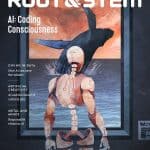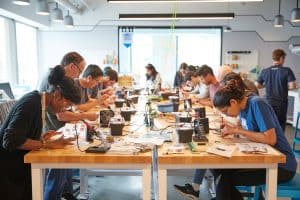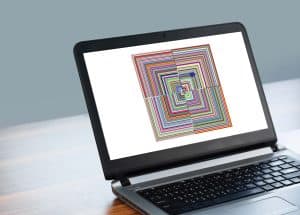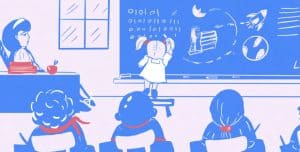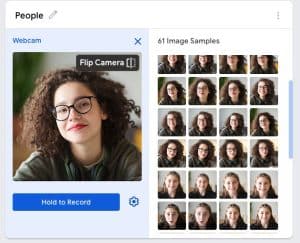This issue of Root & STEM explores how artificial intelligence (AI) is powering profound changes in education, art, and environmental protection. You’ll find articles and resources that explore these topics. From the ways AI is used in industry, how it has changed learning and creativity, and how it is helping scientists understand and catalogue whale calls, this issue asks what kind of world AI is creating and discusses the need for responsibility and ethics in its applications and outcomes.
Guest Editorial
As an artist and researcher, I find artificial intelligence (AI) deeply fascinating. After all, AI is all around us: in search engines, social networks and even Netflix. There’s a conception that technology, including AI, is neutral—but we’ve learned that’s anything but true. Technology is more like a mirror held up to society: along with our progress and successes, it reflects our biases and systemic harms back to us. I believe it’s important for students, especially those who are young, to understand what AI is and how it can reinforce such biases, as well as how we can use it for inspiration (and for art!). This belief drove my collaborator, Bojana Kostic, and I to create a website to help explain what AI is, what we should know about it, what we should be wary of, and how we can use it for creative pursuits. You can learn more on the Explainable Artificial Intelligence website. But here’s a brief primer:
What is AI?
AI on its own really isn’t anything: just lines of code. When it comes to how that code is used in society and how those uses impact people, however—that’s when AI becomes more than just code. In The People’s Guide to AI (written by the fantastic Mimi Ọnụọha and Diana J. Nucera), AI is described as “like salt,” in that when it is added to a product, that product is transformed.
AI can be employed to help software and other tech products accomplish a wide variety of tasks, from sorting or locating information in a search engine to recommending music on Spotify. Forms of AI exist in public spaces such as schools, hospitals and workplaces, as well as in the privacy of our homes.
To function, AI needs data. Data allows AI systems to build patterns, which they then use to generate predictions and simulations, or to infer information about the world. Often, this data is gathered, extracted and mined as a focussed process to build understanding of communities and of how we use technology.
What are the risks of how we use AI?
Since it reflects the biases we build into our technology, AI often makes mistakes and assumptions that are similar to those that people make. For example, in 2013, Harvard University professor Latanya Sweeney was Googling her own name and noticed that her search results prompted ads that read “Latanya Sweeney, arrested?” and “Latanya Sweeney, bail bonds?” Professor Sweeney tried other names that are often associated with Black and African American communities, and the same kind of prompts showed up. Professor Sweeney has never been arrested. This AI prediction is an example of a poorly programmed code that reflects an all-too-common societal bias that Black people are more likely to be incarcerated or in trouble with the law than other communities.
Another example of AI bias was discovered in 2018 by researchers Joy Buolamwini and Dr. Timnit Gebru, in this case related to computer vision and gender. Buolamwini and Gebru discovered that computer vision algorithms, used across major companies like Google, IBM Watson and Amazon, had a difficult time recognizing skin colours and genders. They found that the software was 99 percent correct when identifying white, masculine-presenting faces, and only 35 per cent correct for darker-skinned, feminine-presenting faces. What’s important to realize is that Gebru and Buoalmwini were testing products that are already commercially released, which raises questions about how AI is trained and evaluated to recognize the diversity of people with a high degree of accuracy.
How can AI inspire us?
Of course, not all uses of AI are problematic or harmful. For example, it is being used to create art in interesting ways. The writer and artist K. Allado-McDowell co-wrote a beautiful book with GPT3, a predictive text system created by Open AI, on the nature of human existence. Artist Stephanie Dinkins has created a sculptural chatbot recounting the history of her family and African Americans in the United States. Anna Ridler, a UK-based artist, creates large-scale, handmade datasets and generates AI videos from there. For example, she photographed more than 3,000 tulips and generated an AI video of the tulips moving, rising and falling based on the price of Bitcoin (a nod to the Tulip Crisis of the 1400s and the concept of speculative worth). Just as the invention of the photographic camera created the medium of photography, AI can help artists create new ways of seeing. With any new innovation or technology, it is important to be skeptical and view it with a critical eye—but also to leave space to consider new possibilities. AI is no different—it can amplify biases in harmful ways, but it can also create beauty. It’s this duality that makes artificial intelligence so important, and so complex. As a practitioner, I want us to understand and centre this duality—and to ask: What can we create with AI and how can we also use it to reduce harm in our world?
In this issue of Root & STEM, you’ll find articles and resources that explore these questions. Whether it’s how AI is used in industry, how it has changed learning and creativity, or how it is helping scientists understand and catalogue whale calls, this issue asks what kind of world AI is creating, and how human life is changing as a result.
– Caroline Sinders

Podcasts
We’re excited to launch a new podcast, bringing you an audio version of everything you love about Root & STEM. The podcast expands on our publication, Root & STEM, and explores issues and storytelling with artists, journalists, teachers and communities engaged in STEAM-focused projects. The episodes are approximately 15 minutes long and will be available monthly on the Pinnguaq website, and through popular podcast platforms such as Apple and Spotify.
Featured Content
Below is a collection of stories, activities, comics, and lesson plans featured in the fourth issue of Root & STEM.
